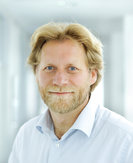THEBEA Therapie-Begleitung und –Analyse für Orthopädie und Unfallchirurgie
Goal
Diseases of the musculoskeletal system are the third most common illness among people over 65 in Germany and are the most frequent reason for surgical interventions. Due to demographic change, the frequency will continue to increase. Younger people are also affected, especially after accidents. The treatment costs for these diseases are over 34 billion euros per year. Added to this are indirect costs for days of incapacity to work, early retirement, rehabilitation, etc. The THEBEA project specifically addresses further treatment after osteosynthetic interventions, i.e. operations in which fractures are splinted with metal plates. The treatment costs for injuries to the hip and thigh as well as the knee and lower leg alone amount to about 5 billion euros annually. A reduction in these costs can be expected by optimising follow-up treatment, which unfortunately is currently suboptimal in many cases: The various players are not networked, which leads to insecurity among those treating and patients and increases the postoperative complication rate. Within the framework of the THEBEA project, a post-treatment system with an app as a central element for therapy support of post-operative and/or post-traumatic patients is being developed for training in the home environment. The system maps treatment processes and connects all involved actors (patients - surgeons - postoperative doctors - physiotherapists).
Individual aftercare goals are set for the patients with the THEBEA system. Physiotherapists create personalised exercise guidelines by demonstrating exercises. These are recorded with the system and converted directly into 3D movement models that take into account the patient's framework conditions (specified by the clinic providing the care and the prosthesis manufacturer). The exercises are displayed to the patients on their smartphone or tablet. Through the 3D reconstruction of the therapists, the image can be rotated in such a way that possible incorrect postures can be presented directly to the patients in order to adjust their movement sequences. In addition to the exercises, the patient is also shown the permissible load corridor. This is made possible by a generic load measurement system for the implants, which is combined with biofeedback. The sensor system records the strength of the load on the joint and the implant and warns when the load is exceeded.
The project, funded by the Federal Ministry of Education and Research, is being realised by a consortium consisting of Herodikos GmbH, Marquardt Medizintechnik GmbH, the Evangelical Hospital Oldenburg, Osnabrück University of Applied Sciences and OFFIS.
Internal Leader
Scientific Director
Maszuhn, Matthias and Müller-von Aschwege, Frerk and Jansen, Felix and Hein, Andreas and Knol, Hester and Snowdon, David and Buschermöhle, Michael and Barth, Dominik and Haag, Luisa and Wohlers, Nadine and others; BIOSTEC (2); 2024
Maszuhn, Matthias and Jansen, Felix and Müller-von Aschwege, Frerk and Hein, Andreas; Proceedings of the 18th International Joint Conference on Biomedical Engineering Systems and Technologies - Volume 2; 001 / 2025
www.herodikos.de
www.marquardt-medizintechnik.de
www.evangelischeskrankenhaus.de
www.hs-osnabrueck.de
www.kizmo.eu
Duration
End: 31.07.2026
Source of funding



